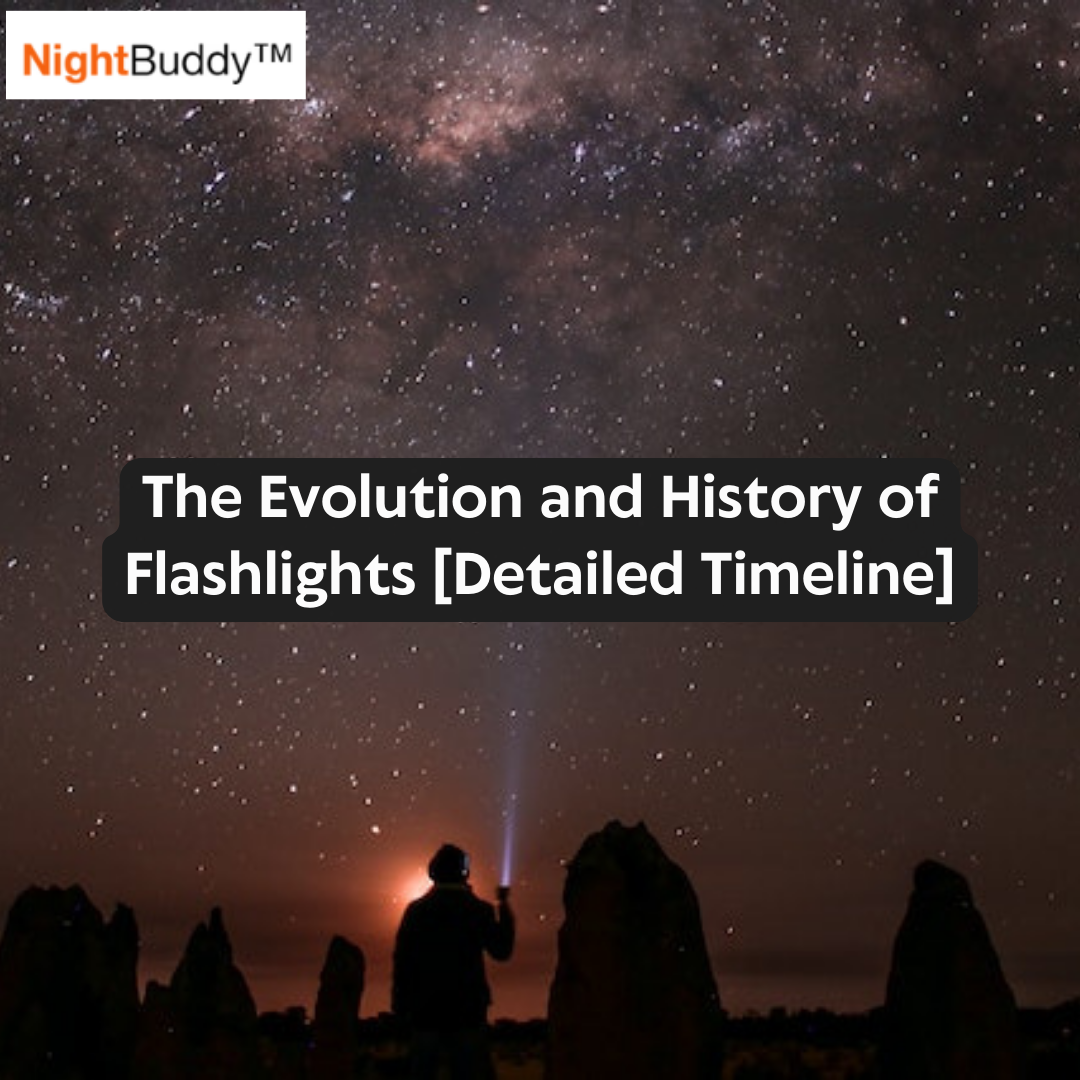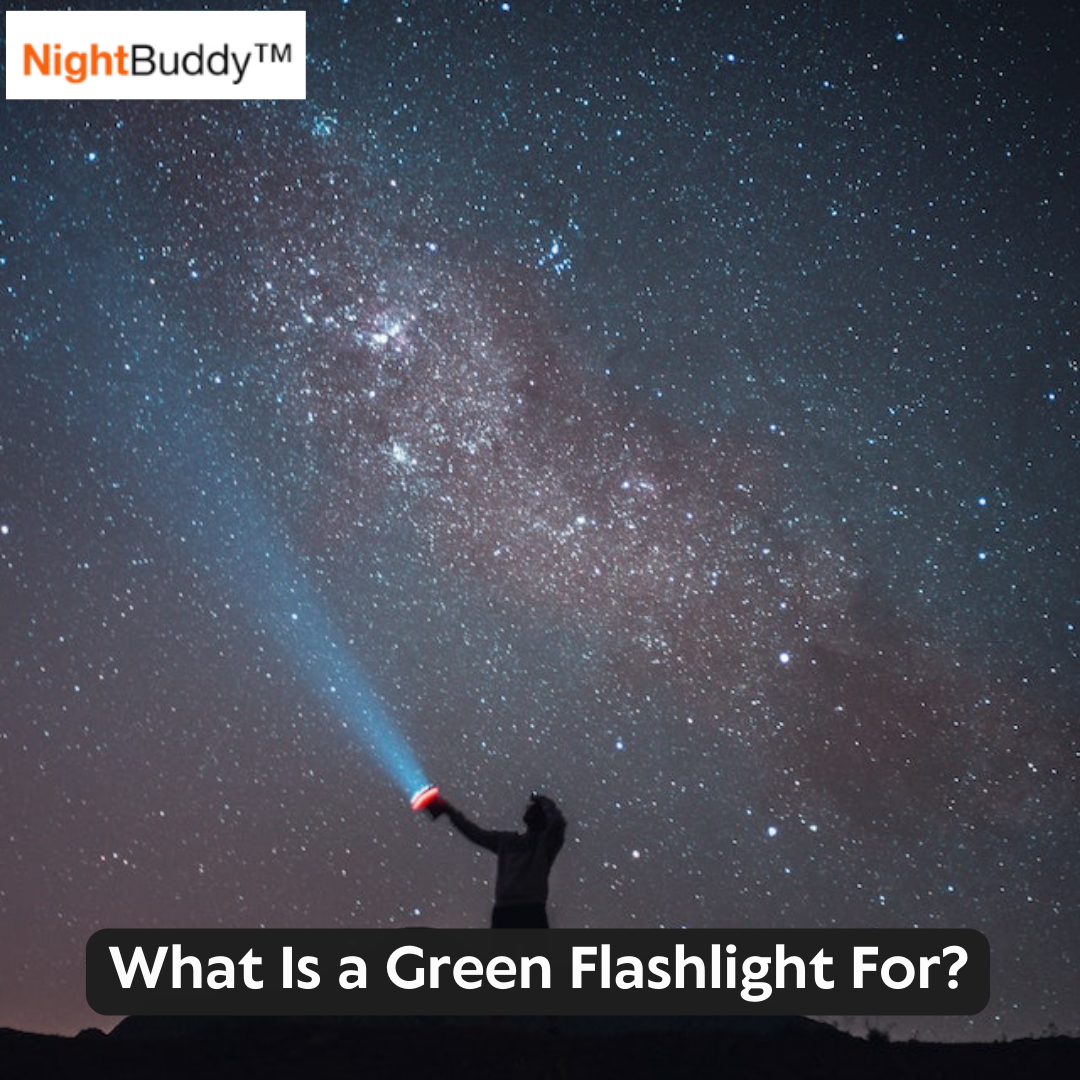Flashlights have become an indispensable part of our lives, whether we're exploring the great outdoors, working in low-light conditions, or navigating power outages. But have you ever wondered about the history of this everyday tool that has evolved into a handheld device such as the Pocket Pen Flashlight NightBuddy? Join us on a journey through time as we explore the fascinating history of flashlights.
From Ancient Fire-Making Tools to the First Electric Flashlight

The concept of portable, handheld light sources can be traced back to ancient times. Ancient humans used various materials such as reeds, twigs, or bark coated in resin or animal fat to create torches that provided light and warmth. These torches were the first portable light sources and were used for thousands of years until the invention the kerosene lamp and electric light.
The invention of the electric flashlight can be attributed to David Misell, a British inventor who patented the first flashlight the tubular flashlight in 1899. Misell's invention was a handheld device that used three D-cell batteries to power a small light bulb. The flashlight was marketed as a portable electric light for miners and other professionals who needed a reliable source of light in dark and dangerous environments.
Misell's tubular flash light was a significant improvement over the torches that were used for thousands of years. It was lightweight, portable, and provided a bright and consistent source of light. The invention of the flashlight marked a new era in portable lighting technology.
However, early flash lights had some limitations. The batteries were bulky, and the bulbs were fragile, making them unsuitable for rough use. In addition, the light emitted by early flashlights was not very bright and had a limited range.
Despite these limitations, the invention of the electric flashlight was a significant milestone in the history of portable lighting technology. It paved the way for further innovations in the field and made it possible for people to work and travel in dark environments with ease and safety.
Over time, flashlights underwent significant changes in design and technology. The introduction of new materials, such as lightweight plastics, made it possible to create smaller and more durable flashlights. Innovations such as the movable reflector, ability to use smaller cell sizes, rechargeable batteries, and LED technology have further improved the functionality and efficiency of flashlights.
Today, flashlights are essential tools used in a wide range of industries, including law enforcement, military, construction, and emergency services. They are also popular among outdoor enthusiasts and everyday consumers who need a reliable source of light in various situations.
The Evolution of Flashlights: Changes in Technology and Design
Flashlights have undergone significant changes in technology and design since its invention in the late 19th century. Innovations in materials, power sources, and bulb technology have made flashlights smaller, brighter, and more durable over time.
One of the most significant changes in flashlight design was the introduction of new light materials. Early flashlights were made of heavy metals such as brass and copper, which made them bulky and difficult for flashlight users to carry. In the 1960s, the introduction of lightweight plastics revolutionised flashlight design. Plastic flashlights were lightweight, durable, and affordable, making them accessible to a wider range of people.
Another significant change in flashlight technology was the introduction of rechargeable batteries. Early flashlights used disposable batteries, dry cell batteries were not only expensive but also harmful to the environment. Rechargeable batteries which have become the most common power source that run on stored electric current allowed flashlights to be used for longer periods, saving money and reducing waste.
In the 1990s, the invention of light-emitting diode (LED) technology transformed flashlight design. LEDs are smaller, brighter, and more energy-efficient than traditional incandescent light bulbs. LED flashlights use less power hence smaller cell sizes, produce less heat, and last longer than incandescent lights. They also come in a range of colored light and are less likely to break if dropped.
Flashlight size and shape have also changed over time. Traditional flashlights were cylindrical and bulky, making them difficult to carry in pockets or bags. Today, flashlights come in a range of sizes, shapes, and designs. Some are as small as a keychain, while others are designed to be mounted on helmets or rifles. These compact and specialized flashlights are popular among law enforcement, military, and outdoor enthusiasts.
In addition to being superior to incandescent lamps, modern flashlights came with the introduction of new features which have expanded the functionality of flashlights. Some flashlights have built-in cameras, GPS tracking, and USB charging ports. Others are designed to be waterproof, shockproof, or explosion-proof, making them suitable for use in harsh environments.
Flashlights in War and Emergencies: How They Became Essential Tools

Flashlights have become essential tools in war and emergencies, helping to save lives and provide illumination in dark and dangerous environments. The portability, durability, and reliability of everyday flashlights have made them indispensable to military personnel, emergency responders, and civilians alike.
In war, flashlights are critical tools for soldiers who operate in low-light conditions. Nighttime operations and maneuvers require the use of specialized flashlights that emit infrared light, allowing soldiers to navigate in the dark without being detected by the enemy.
Flashlights are also used to illuminate targets, identify threats, and signal to other members of the team. In addition, flashlights are essential for military engineers who work in tunnels, mines, and other underground structures where natural light is scarce.
In emergency situations, flashlights are indispensable tools for rescue workers and civilians. In natural disasters such as hurricanes, tornadoes, and earthquakes, power outages are common, leaving people without electricity and in the dark.
Flashlights provide essential illumination for rescue workers who search for survivors in collapsed buildings or other dangerous situations. They also help civilians navigate in the dark, locate supplies, and signal for help.
Flashlights are also critical tools for first responders, such as police officers, firefighters, and paramedics. Police officers use flashlights to search for suspects and evidence, while firefighters use them to navigate through smoke-filled buildings and locate victims.
Paramedics use flashlights to examine wounds, administer medication, and perform other medical procedures in low-light conditions.
In addition to their primary use as illumination tools, flashlights have other features that make them indispensable in emergencies.
Many everyday flashlights are designed to be waterproof, shockproof, and resistant to extreme temperatures, making them suitable for use in harsh environments. Some flashlights are also equipped with emergency strobe lights, which can be used to signal for help or to warn other people of danger.
Flashlights Today: Modern Innovations and Everyday Uses

Flashlights have come a long way from their humble beginnings as bulky, heavy metal cylinders with dim bulbs. Today, flashlights are sleek, lightweight, and come with a wide range of features that make them useful in many everyday situations. Modern innovations in flashlight technology have made them brighter, more energy-efficient, and more durable than ever before.
One of the most significant innovations in flashlight technology today is the use of LED lights. LED lights are smaller, brighter, and more energy-efficient than traditional incandescent bulbs.
Unlike incandescent lamps, LED flashlights use less power, produce less heat, and last longer than incandescent bulb flashlights. They also come in a range of colors and are less likely to break if dropped. As a result, LED flashlights are replacing incandescent lamps among outdoor enthusiasts, campers, hikers, and homeowners alike.
Another modern innovation in flashlight technology is the use of rechargeable batteries. Rechargeable batteries are more cost-effective and eco-friendly than disposable batteries, and they last longer.
Modern rechargeable batteries are also more powerful than their predecessors, providing longer run times and higher output. This makes rechargeable flashlights a popular choice for people who use flashlights regularly.
Flashlights have also become more specialized in recent years. Some flashlights are designed with the flashlight user in mind for specific activities, such as camping, hunting, or mountaineering.
These flashlights come with specialized features such as adjustable focus, waterproofing, and high-intensity beams. Others are designed for everyday use, such as the compact and powerful keychain flashlights that are useful for finding your way in the dark.
Flashlights also have a range of everyday uses. They are useful for power outages, for finding lost items in dark corners, or for changing a tire on the side of the road at night. They can also be used for safety purposes, such as when walking or jogging at night or when exploring a dark area.
In addition, many flashlights are equipped with features such as strobe lights or emergency flashing lights that can be used to signal for help or to alert others to danger.
Common Types of Flashlights
Here are some common types of flashlights:
- Tactical Flashlights: These are designed for law enforcement and military personnel. They have high-intensity beams, strobe features, multiple colored light and may also have strike bezels for self-defense purposes. AN example is the NightBuddy Military Grade Tactical Flashlight.
- Headlamps: These are hands-free flashlights that attach to your head. They are commonly used by hikers, campers, and outdoor enthusiasts, and are also useful for DIY tasks that require hands-free illumination. Nightbuddy offers the best headlamps for your needs.
- Keychain Flashlights: These are small and compact flashlights that can fit on a keychain. They are ideal for everyday use and are commonly used for finding things in dark places, like a car or purse.
- Lanterns: These are larger, usually battery-powered lights that provide a wider area of illumination. They are useful for camping trips, power outages, and other situations where you need more light than a traditional flashlight can provide.
- Dive Lights: These are waterproof flashlights designed for scuba diving or other water-based activities. They typically have high-lumen outputs and long battery life.
- UV Flashlights: These emit ultraviolet light and are used for tasks like detecting counterfeit money, examining pet urine stains, and identifying scorpions or other insects.
- Rechargeable Flashlights: These flashlights can be recharged using a USB port, solar panel, or other charging methods, and are more environmentally friendly and cost-effective than disposable battery flashlights.
- Portable Flashlights: Portable flashlights are a type of flashlight that are designed to be easy to carry and transport. They are ideal for situations where you need a light source on the go.
- Angle head flashlights: Angle head flashlights are a specific type of flashlight that have a unique angled head design. The head of the flashlight can be rotated or tilted, allowing the user to direct the beam of light in different directions without having to adjust the position of the entire flashlight.
- Luxeon LED flashlights: Luxeon LED flashlights are a type of flashlight that use Luxeon LEDs as their light source. Luxeon LED flashlights are a high-performance type of LED flashlights that produce a bright, white light with a long lifespan and high energy efficiency.
- Dynamo-powered flashlights: Dynamo-powered flashlights, also known as hand-crank flashlights, are a type of flashlight powered by a hand-crank generator. These flashlights do not require batteries or an external power source, making them a reliable and sustainable lighting option for emergency preparedness kits or outdoor adventures.
- Black light flashlights: Black light flashlights, also known as UV flashlights, are a type of flashlight that emit ultraviolet (UV) light. Unlike traditional flashlights that produce visible light, black light flashlights produce a beam of light that is invisible to the human eye but can cause certain materials to fluoresce or glow in the dark.
How lanterns and modern flashlights complement

Lanterns and modern flashlights complement each other well because they serve different purposes and provide different types of illumination. Lanterns are typically larger and provide a wider area of illumination, making them ideal for lighting up a campsite or a room during a power outage.
Modern flashlights, on the other hand, are smaller and more portable, making them ideal for tasks that require more focused illumination, like hiking or searching for something in the dark.
Lanterns and modern flashlights are both important tools to have on hand for outdoor activities, emergencies, and everyday use. Together, they provide a range of lighting options to help you navigate in the dark and stay safe and prepared.
Common types of lanterns
- Electric Lanterns: These are traditional lanterns that are powered by electricity. They typically have a bulb or LED light source and are either rechargeable or require replaceable batteries.
- Hand-Crank Lanterns: These are lanterns that are powered by a hand-crank mechanism. They are often used in emergency situations when power sources are not available.
- LED Lanterns: These are lanterns that use LED lights as their light source. They are energy-efficient and have a long battery life, making them ideal for camping trips and other outdoor activities. NightBuddy Rechargeable LED Lantern is one of the best lanterns on the market.
- Fluorescent lamps: These lanterns use fluorescent light bulbs as their light source instead of the more traditional incandescent bulbs. Fluorescent lanterns are often more energy-efficient and have a longer battery life than lanterns that use incandescent bulbs.
- Battle lanterns: Battle lanterns are often used by soldiers during nighttime operations to provide light in situations where other forms of illumination, such as flashlights or headlamps, may not be practical or effective.
Read more: The 5 Top Benefits of LED Flashlights
Wondering how to choose the best flashlights that meets your needs? Worry no more! Nightbuddy has prepared a flashlight buying guide detailing the qualities to look for and where exactly. You can sample some best flashlights as a gift for yourself or your traveler friend. Feel free to reach us, you can also send us an email: info@nightbuddy.co





Leave a comment
This site is protected by hCaptcha and the hCaptcha Privacy Policy and Terms of Service apply.